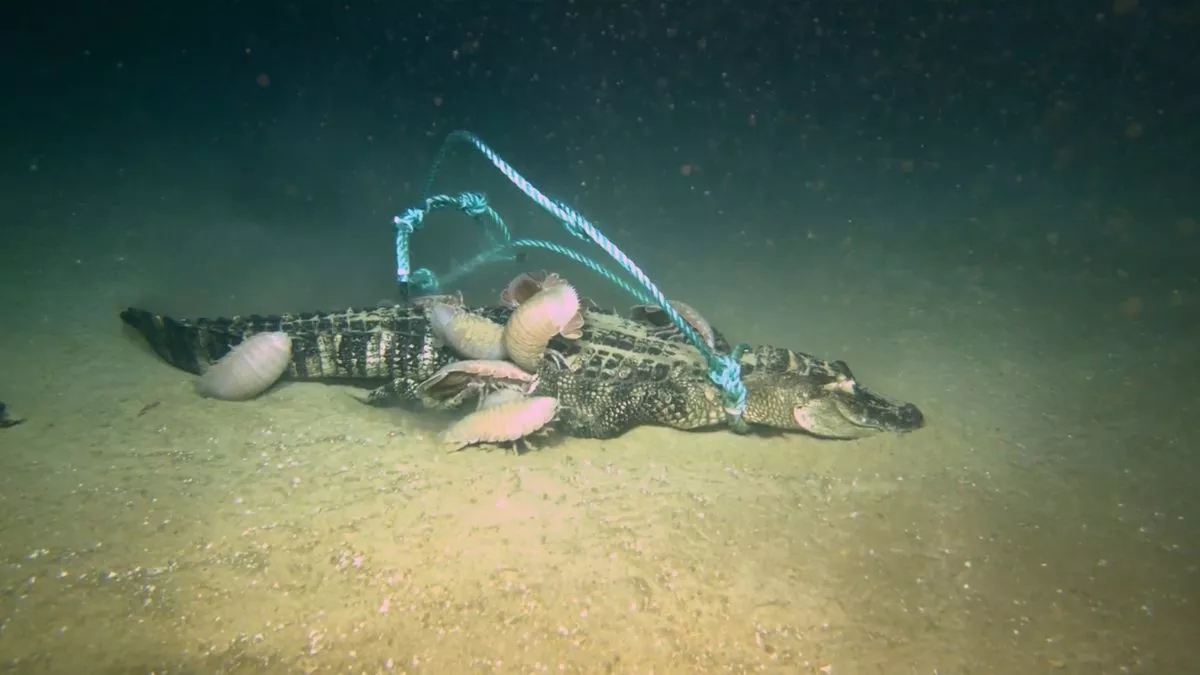Another experiment to find out what kind of life exists on the seafloor has raised the chance of a gigantic animal lurking in the dark profundities of the ocean. Is it a gigantic shark or a giant squid? Or on the other hand, something we don’t for a moment even have a name for?

The Great Gator Experiment involved sinking three alligator corpses to the bottom of the ocean to see what happens to them.
Up to this point, we have only investigated about 5% of Earth’s oceans, which amount to 70 percent of our planet’s surface. The profundities of the sea conceal privileged insights that humans have forever been interested in.
To get further insights into what’s rolling on the ocean floor, marine biologists Craig McClain and Clifton Nunnally from Louisiana Colleges Marine Consortium, carried out an experiment, known as the Great Gator Experiment, and the outcomes are interesting, to say the least.
The researchers sank a smorgasbord for puzzling seafloor creatures which included three dead alligators, with loads attached to them. They were interested in perceiving how their corpses would be consumed by creatures lurking on the seafloor.
“To investigate the food web somewhere inside the sea, we placed three dead alligators at least 6,600 feet down in the Bay of Mexico for 51 days,” said Clifton Nunnally from Louisiana University.
After sinking to the neglected profundities of the ocean, the gators hit the seafloor and settled among the upset residue.
What came next was very shocking.
The main gator was consumed within 24 hours of hitting the ocean floor. It was immediately invited by giant isopods, which according to Nunnally, are like remote ocean vultures. Then, other scavengers like amphipods, grenadiers, and some baffling, unidentifiable black fish joined the feast. The isopods tore apart the reptile faster than the scientists anticipated, eating it inside out.
The subsequent alligator was eaten during a more drawn-out timeframe. After 51 days, all that remained of it was its skeleton, which had a rosy tone.
“That one genuinely astonished us. There was not so much as a single scale or scute left on the carcass,” McClain told Atlas Obscura. The team then sent the skeleton to Greg Stir, a marine biologist at the Scripps Institution of Oceanography, for further scrutiny.
Stir found that the gator had been separated into shackles of bone by another type of bone-eating worm in the Osedax variety. This was the initial occasion when an Osedax part was tracked down in the Bay of Mexico, according to McClain. The researchers then compared the recently obtained DNA to those of the already-known Osedax species and realized they had tracked down clever types of the class.

Also known as zombie worms, Osedax bore into the bones of whale carcasses to reach encased lipids, on which they depend for sustenance.
Despite the surprising disclosure of another Osedax species, it was the third alligator that left the scientists the most baffled. While visiting the site where the third gator was dropped, they could only see a massive misery in the sand – the animal had vanished altogether. The team then searched the surrounding area however they tracked down no trace of the alligator. Nonetheless, they found the weight attached to the gator, which lay about 10 meters away from the site.
What this means is that the predator that cleared away the gator was sufficiently tremendous to gobble up it entirely and drag the attached load for some distance. The team thinks the creature to be either a giant squid or a massive shark waiting to be discovered. “I have yet to find a squid that could consume an entire alligator, and I would rather not be on the boat assuming we at any point find it.”
The two researchers were stunned about the outcomes, and also exceptionally satisfied with the experiment. They plan to do a whale fall sometime later.

The researchers are planning to sink a dead whale sometime later and see what happens.
Will the puzzling carnivore end up being the Kraken – a legendary sea beast of gigantic size and cephalopod-like appearance in Scandinavian fables? Or on the other hand, something else we have never at any point considered? Indeed, we can’t wait to find out.
Read also: Scientists have discovered a 400-year-old Greenland shark that may have been born around 1620.

